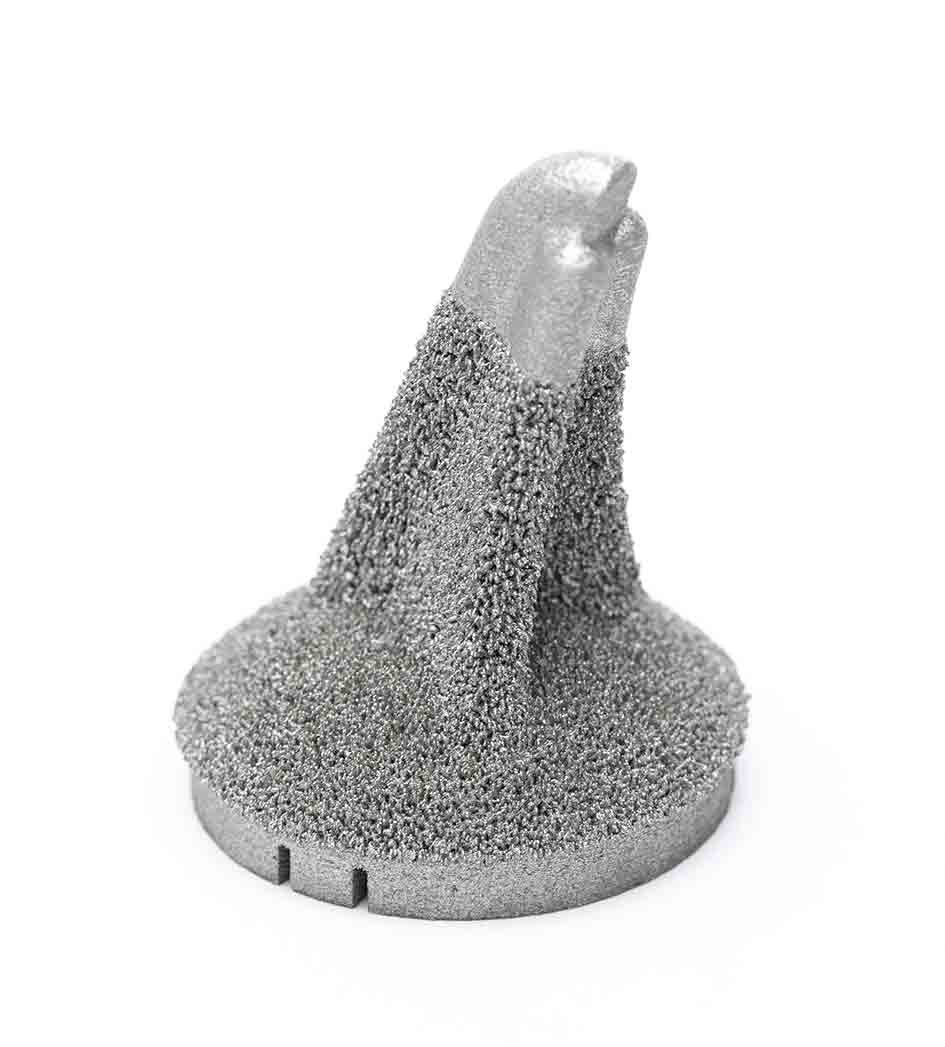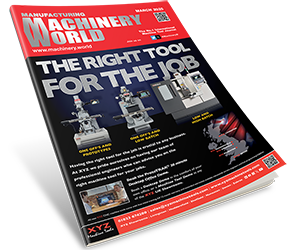Additive Manufacturing (AM) has grown in importance over the past decade to become a significant part of the orthopaedics industry. Estimates produced in 2022 indicated that over 10% of all components used in hip, knee, shoulder and trauma implants would be made using AM by 2023/24.
The drivers behind this trend are many, but foremost is patient benefit.
Both OEM’s and contract manufacturers are investing in both the machinery and the personnel needed to bring this technology in to their operations. One of the first challenges, however, is to integrate an AM process into a factory and integrate it with other manufacturing processes such as milling and laser marking.
In this article a customised shoulder implant using a GF Machining Solutions’ DMP Flex 350 flexible metal 3D printer is used to manufacture high-quality precision implant parts.
This technology, integrated with a range of ‘other’ technologies from GF Machining Solutions (i.e., milling, laser marking etc.,) has definite advantages over traditional manufacturing methods. This alternative process and the technologies employed is highlighted below.
Shoulder implants – demand trends
Take the manufacture of part of a shoulder implant (aka the humeral stem) as an example
Like many other joint replacements (such as hip and knee), shoulder replacement surgery is growing significantly due, to a large extent, to the needs of an aging population and an increased participation, by many people, in extreme sports
With over 100,000 operations a year and a growth rate of 8%, shoulder replacement surgery requires a large volume of high quality components.
Traditional vs AM manufacture
With a traditionally manufactured product, the humeral stem often starts as either a casting or as a forged blank. Either way, the first step is to design and manufacture the mould or forging dies. Once this is completed, a blank stem is made and then finish milled.
The milled stem is then washed, masked, and sand (or “grit”) blasted, and coated typically with hydroxyapatite (a white powder containing both calcium and phosphate that promotes bone growth). Overall, there are about eight different and major steps to make the device (not counting quality checks).
Issues with ‘Traditional Manufacturing’ methods
Traditional forged implants can suffer from phenomena known as a) stress shielding (when and where reduction in bone density or osteopenia occurs as a result of the removal of stress from the bone caused by an implant, and b) loosening (when new bone does not adequately fix the implant to the arm).
AM manufactured implants deliver improved benefits over traditional manufacturing methods and can help reduce stress shielding and improved osseo-integration (attachment to bone).
In the AM process, a plate of humeral stems is printed by growing the part, layer by layer, using a laser to fuse a bed of titanium powder. These layers are often made using a lattice structure that helps promote bone growth.
Such lattice structures are not always coated with hydroxyapatite and, as a consequence, the AM process has generally about three fewer steps than traditional manufacturing methods.
AM does, however, bring its own set of challenges in the manufacture of implants, but thanks to GF Machining Solutions’ technologies and application know-how, these challenges have been overcome.
The first two steps in the AM process are first to create a product design and then secondly prepare that design for printing.
3DXpertTM is a software package that allows control over the complete Additive workflow.
Users can either import a product CAD file into the system – or create a bespoke design from scratch.
In order to gain the maximum benefits that AM can bring, the implant product we have designed includes a porous structure made from many lattices. This type of geometry is much better for osseo-integration. Creating a design with thousands of lattices requires powerful software, and 3DXpertTM is up to the task.
3DXpertTM creates lattices either using its internal library, or from a user defined structure. It provides almost limitless possibilities giving manufacturers the ability to create a unique and differentiated structure of their own design
It also has the ability to analyse the mechanical behaviour of a lattice so that structures can be fine-tuned and more accurately match the “compliance” (or elasticity and behaviour) of human bone – reducing the risk of stress shielding and thus making a better-performing and reliable implant.
Once the design process is completed, the device is printed from a bed of titanium powder.
Titanium is highly reactive with any oxygen, becoming more brittle as oxygen levels increase.
Control over the level of oxygen in the build chamber is therefore key to making a good implant product. Where many commercial metal printers operate with oxygen levels between 500 – 700ppm (causing material properties to degrade quickly over time), GF Machining Solutions’ DMP 350 benefits from a vacuum chamber that evacuates air at the start of the print cycle, replacing it with Argon.
Owing to this, the DMP 350 operates at an industry leading oxygen level of 25ppm, ensuring product quality and uniform results, build after build.
During printing, the laser interacts with, and melts, the powder. The creation of micro-particles (a by-product of the process), which can fall back into the print zone and cause part defects is prevented due to a gas flow that ensures particles are kept away from the print area.
Finally, to ensure an accurate and repeatable process, relevant, ‘real-time’ monitoring and verification data is captured throughout the process via the DMP 350’s industrial camera and photo-diodes that constantly monitor the melt pool during the printing cycle.
Through inspection software that is available in 3DXpertTM, the data produced during printing can be analysed with any quality and process issues highlighted.
Following printing and stress relieving, the shoulder implant will require a number of secondary machining operations to be performed to manufacture the completed part.
Zero point chucks
Designing the device and planning for product clamping using a zero-point chuck is key to the efficient integration of downstream operations. To do this, System 3R’s zero-point chuck systems are used.
This simple and very accurate clamping device is found on the DMP 350, and as the interface for every manufacturing step in the process described below.
The System 3R zero point chuck also has a configuration that allows mini “BuildPals” or build pallets that a 3D printer can use and allows individual parts to be positioned for secondary machining while still on the build plate.
System 3R’s Macro chuck system ensures accuracy and allows automatic loading into almost any type of machine in seconds. The integration of an RFID chip in the pallet base allows for product tracking information and simplifies shop floor management.
Milling
The shoulder implant has vertical tabs with a tapered wall to interface with the plastic spacer, locking it place. These tabs are machined to tight tolerances and very smooth surface finishes, avoiding the creation of burrs when inserted into the spacer.
Achieving these results reliably, batch after batch, requires a precise machine. As a consequence, the GF Machining Solutions’ Mikron MILL S 400 U (5-axis machining centre) was elected to undertake the milling operations.
The machine design integrates over 100m of water cooling channels within its base to provide thermal stability. It is also equipped with AMC (Automatic Machine Calibration) which allows an operator to calibrate the system in just a few minutes.
Laser marking
After milling is completed, the implant is transferred to an AgieCharmilles’ Laser P 400 U.
The Laser P 400 U is a 5-axis machining centre that can be equipped with a range of lasers including nanosecond and femtosecond sources, and different wavelengths.
With our implant example, the part is automatically loaded into the laser machine, which then writes the product UDI (Unique Device Identification) number on to the Shoulder Implant (for traceability), as well as producing other graphic elements such as a logo or a 2D bar code.
Summary
Additive Manufacturing is a technology that can drive significant improvements for medical devices such as shoulder implants. The patient benefits and the increasing use of this technology is driving both OEM’s and medical contract manufacturers to invest.
As with any new technology, integration into an existing plant can present challenges.
However, understanding the technology and working with a partner that can not only supply and integrate all the ancillary technologies, but also understand the complete production flow, including future automated manufacture, can help ensure the investments made are a success.
That partner is GF Machining Solutions.







